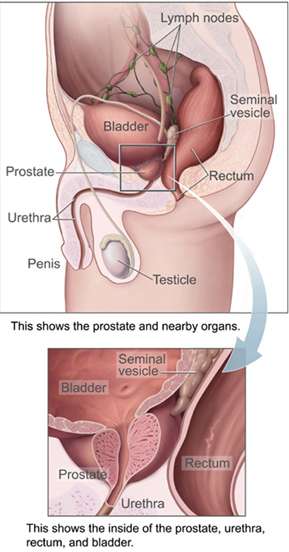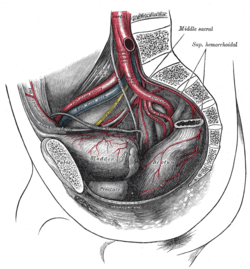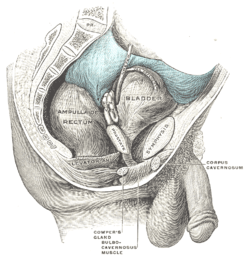Chronic bacterial prostatitis
| Chronic Bacterial Prostatitis | |
|---|---|
 | |
| Classification and external resources | |
| Specialty | urology |
| ICD-10 | N41.1 |
| ICD-9-CM | 601.1 |
| DiseasesDB | 10801 |
| MedlinePlus | 000523 |
| eMedicine | med/1920 |
| MeSH | D011472 |
Chronic bacterial prostatitis is a bacterial infection of the prostate gland. It should be distinguished from other forms of prostatitis such as acute bacterial prostatitis and chronic pelvic pain syndrome (CPPS).[1]
Signs and symptoms
Chronic bacterial prostatitis is a relatively rare condition that usually presents with an intermittent UTI-type picture. It is defined as recurrent urinary tract infections in men originating from a chronic infection in the prostate. Symptoms may be completely absent until there is also bladder infection, and the most troublesome problem is usually recurrent cystitis.[2]
Chronic bacterial prostatitis occurs in less than 5% of patients with prostate-related non-BPH lower urinary tract symptoms (LUTS).
Dr. Weidner, Professor of Medicine, Department of Urology, University of Gießen, has stated: "In studies of 656 men, we seldom found chronic bacterial prostatitis. It is truly a rare disease. Most of those were E-coli."[3]
Diagnosis
In chronic bacterial prostatitis there are bacteria in the prostate, but there may be no symptoms or milder symptoms than occur with acute prostatitis.[4] The prostate infection is diagnosed by culturing urine as well as prostate fluid (expressed prostatic secretions or EPS) which are obtained by the doctor performing a rectal exam and putting pressure on the prostate. If no fluid is recovered after this prostatic massage, a post massage urine should also contain any prostatic bacteria.
Prostate specific antigen levels may be elevated, although there is no malignancy. Semen analysis is a useful diagnostic tool.[5] Semen cultures are also performed. Antibiotic sensitivity testing is also done to select the appropriate antibiotic. Other useful markers of infection are seminal elastase and seminal cytokines.
Treatment
Antibiotic therapy has to overcome the blood/prostate barrier that prevents many antibiotics from reaching levels that are higher than minimum inhibitory concentration.[6] A blood-prostate barrier restricts cell and molecular movement across the rat ventral prostate epithelium.[7] Treatment requires prolonged courses (4–8 weeks) of antibiotics that penetrate the prostate well.[8] The fluoroquinolones, tetracyclines and macrolides have the best penetration. There have been contradictory findings regarding the penetrability of nitrofurantoin , quinolones (ciprofloxacin, levofloxacin), sulfas (Bactrim, Septra), doxycycline and macrolides (erythromycin, clarithromycin). This is particularly true for gram-positive infections.
In a review of multiple studies, Levofloxacin (Levaquin) was found to reach prostatic fluid concentrations 5.5 times higher than Ciprofloxacin, indicating a greater ability to penetrate the prostate.[9]
Persistent infections may be helped in 80% of patients by the use of alpha blockers (tamsulosin (Flomax), alfuzosin), or long term low dose antibiotic therapy.[10] Recurrent infections may be caused by inefficient urination (benign prostatic hypertrophy, neurogenic bladder), prostatic stones or a structural abnormality that acts as a reservoir for infection.
In theory, the ability of some strains of bacteria to form biofilms might be one factor amongst others to facilitate development of chronic bacterial prostatitis.[11]
Escherichia coli extract and cranberry have a potentially preventive effect on the development of chronic bacterial prostatitis,[12] while combining antibiotics with saw palmetto, lactobacillus sporogens and arbutin may lead to better treatment outcomes.[13]
Bacteriophages hold promise as another potential treatment for chronic bacterial prostatatis.[14]
The addition of prostate massage to courses of antibiotics was previously proposed as being beneficial and prostate massage may mechanically break up the biofilm and enhance the drainage of the prostate gland.[15][16] However, in more recent trials, this was not shown to improve outcome compared to antibiotics alone.[17]
Prognosis
Over time, the relapse rate is high, exceeding 50%. However, recent research indicates that combination therapies offer a better prognosis than antibiotics alone.
A 2007 study showed that repeated combination pharmacological therapy with antibacterial agents (ciprofloxacin/azithromycin), alpha-blockers (alfuzosin) and Serenoa repens extracts may eradicate infection in 83.9% of patients with clinical remission extending throughout a follow-up period of 30 months for 94% of these patients.[18]
A 2014 study of 210 patients randomized into two treatment groups found that recurrence occurred within 2 months in 27.6% of the group using antibiotics alone (prulifloxacin 600 mg), but in only 7.8% of the group taking prulifloxacin in combination with Serenoa repens extract, Lactobacillus Sporogens and Arbutin.[13]
References
- ↑ Holt JD1 et al. Common Questions About Chronic Prostatitis. Am Fam Physician. 2016 Feb 15;93(4):290-6. PMID 26926816
- ↑ Habermacher GM, Chason JT, Schaeffer AJ (2006). "Prostatitis/chronic pelvic pain syndrome". Annu. Rev. Med. 57 (1): 195–206. doi:10.1146/annurev.med.57.011205.135654. PMID 16409145.
- ↑ Schneider H, Ludwig M, Hossain HM, Diemer T, Weidner W (2003). "The 2001 Gießen Cohort Study on patients with prostatitis syndrome--an evaluation of inflammatory status and search for microorganisms 10 years after a first analysis". Andrologia. 35 (5): 258–62. doi:10.1046/j.1439-0272.2003.00586.x. PMID 14535851.
- ↑ "Prostatitis - Symptoms". NHS Choices.
- ↑ Magri V, Wagenlehner FM, Montanari E, et al. (April 2009). "Semen analysis in chronic bacterial prostatitis: diagnostic and therapeutic implications". Asian Journal of Andrology. 11 (4): 461–77. doi:10.1038/aja.2009.5. PMID 19377490.
- ↑ Brant R. Fulmer; Terry T. Turner (May 2000). "A blood-prostate barrier restricts cell and molecular movement across the rat ventral prostate epithelium". The Journal of Urology. American Urological Association. 16 (5): 1591–4. doi:10.1016/S0022-5347(05)67685-9. PMID 10751894.
- ↑ M Barza (January 1993). "Anatomical barriers for antimicrobial agents". Eur J Clin Microbiol Infect Dis. 12 (Suppl 1): S31–5. doi:10.1007/BF02389875. PMID 8477760.
- ↑ Charalabopoulos K, Karachalios G, Baltogiannis D, Charalabopoulos A, Giannakopoulos X, Sofikitis N (2003). "Penetration of antimocrobial agents into the prostate" (PDF). Chemotherapy. 49 (6): 269–279. doi:10.1159/000074526. PMID 14671426.
- ↑ "Levofloxacin and Its Effective Use in the Review Management of Bacterial Prostatitis" (PDF).
- ↑ Shoskes DA, Hakim L, Ghoniem G, Jackson CL (2003). "Long-term results of multimodal therapy for chronic prostatitis/chronic pelvic pain syndrome". J. Urol. 169 (4): 1406–10. doi:10.1097/01.ju.0000055549.95490.3c. PMID 12629373.
- ↑ Wagenlehner FM, Pilatz A, Bschleipfer T, et al. (August 2013). "Bacterial prostatitis". World Journal of Urology. 31 (4): 711–6. doi:10.1007/s00345-013-1055-x. PMID 23519458.
- ↑ Kim, SH.; Ha, US.; Lee, HR.; Sohn, DW.; Lee, SJ.; Kim, HW.; Han, CH.; Lee, CB.; Cho, YH. (Nov 2010). "Do Escherichia coli extract and cranberry exert preventive effects on chronic bacterial prostatitis? Pilot study using an animal model". J Infect Chemother. 17 (3): 322–6. doi:10.1007/s10156-010-0170-5. PMID 21042827.
- 1 2 Busetto GM, Giovannone R, Ferro M, et al. (2014). "Chronic bacterial prostatitis: efficacy of short-lasting antibiotic therapy with prulifloxacin (Unidrox®) in association with saw palmetto extract, lactobacillus sporogens and arbutin (Lactorepens®)". BMC Urology. 14 (1): 53. doi:10.1186/1471-2490-14-53. PMC 4108969
 . PMID 25038794.
. PMID 25038794. - ↑ Letkiewicz S, Międzybrodzki R, Kłak M, Jończyk E, Weber-Dąbrowska B, Górski A (November 2010). "The perspectives of the application of phage therapy in chronic bacterial prostatitis". FEMS Immunology & Medical Microbiology. Federation of European Microbiological Societies. 60 (2): 99–112. doi:10.1111/j.1574-695X.2010.00723.x. PMID 20698884.
- ↑ Nickel JC, Downey J, Feliciano AE, Hennenfent B (1999). "Repetitive prostatic massage therapy for chronic refractory prostatitis: the Philippine experience". Techniques in Urology. 5 (3): 146–51. PMID 10527258.
- ↑ Shoskes DA, Zeitlin SI (1999). "Use of prostatic massage in combination with antibiotics in the treatment of chronic prostatitis". Prostate Cancer and Prostatic Diseases. 2 (3): 159–162. doi:10.1038/sj.pcan.4500308. PMID 12496826.
- ↑ Ateya A, Fayez A, Hani R, Zohdy W, Gabbar MA, Shamloul R (2006). "Evaluation of prostatic massage in treatment of chronic prostatitis". Urology. 67 (4): 674–8. doi:10.1016/j.urology.2005.10.021. PMID 16566972.
- ↑ Magri V, Trinchieri A, Pozzi G, et al. (May 2007). "Efficacy of repeated cycles of combination therapy for the eradication of infecting organisms in chronic bacterial prostatitis". Int. J. Antimicrob. Agents. 29 (5): 549–56. doi:10.1016/j.ijantimicag.2006.09.027. PMID 17336504.
External links
Additional images
 Prostate, urethra, and seminal vesicles.
Prostate, urethra, and seminal vesicles. The arteries of the pelvis.
The arteries of the pelvis. Male pelvic organs seen from right side.
Male pelvic organs seen from right side.
